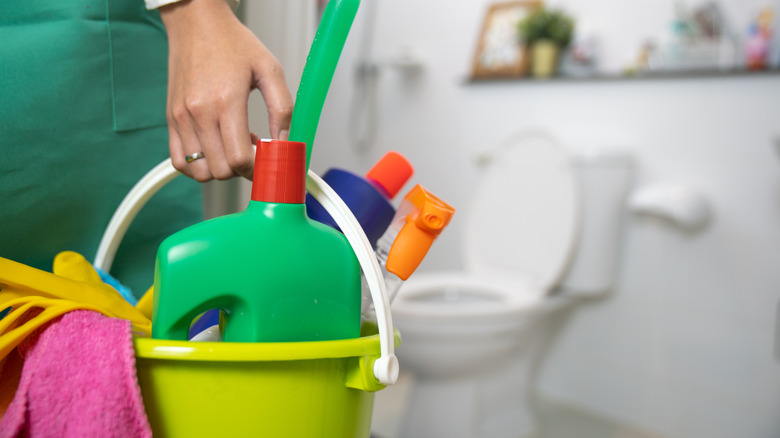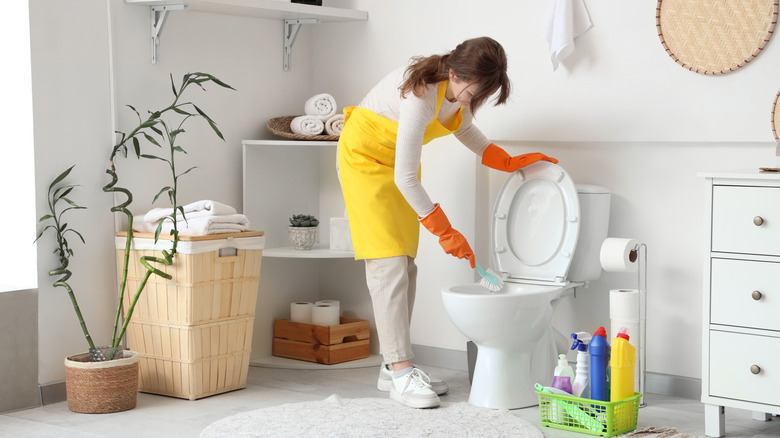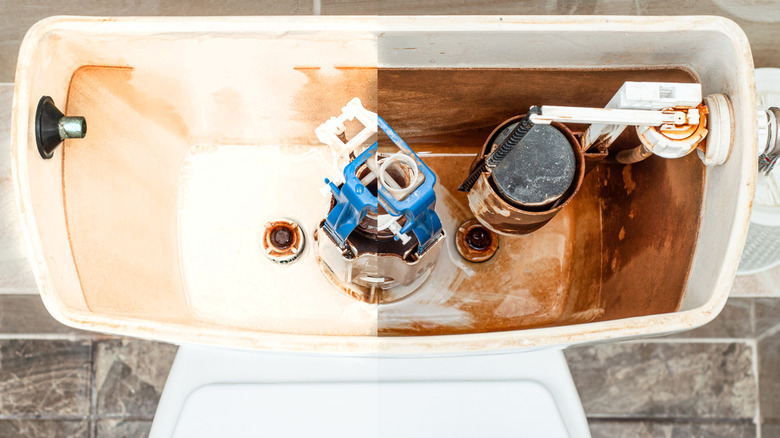Everyone Forgets To Clean This Part Of Their Bathroom And We Can Smell It
We may receive a commission on purchases made from links.
You have just finished cleaning the bathroom, and you're so happy. It's a chore no one likes to do, so you're glad it's totally done for now. But what would you say if we told you that there is part of your bathroom that you may be forgetting to clean, and your bathroom wasn't as fresh as you think it is? You might think that you covered everything — the sink, the shower, the tub, the floor, and of course, the toilet. And yet, everyone forgets to clean this part of their bathroom, and we can smell it. With an odor like this, it's likely the toilet. Could it be the toilet handle (or flush button if that is the style your toilet has)? Overlooking that germy spot when cleaning the toilet is a big mistake. No again: It's the area behind the toilet and around its base.
We're often so focused on the toilet seat and bowl that it can be easy to forget what is right underneath the bowl (much less the back of it). But take a look. Stifle the urge to say, "How does that even get there?" and focus on what to do about it now. Accumulated ickiness isn't just smelly, it's also unsanitary. The good news is that we have great tips on how to make the job easier.
Easier cleaning behind and around the toilet
Not cleaning behind and around the base of your toilet can stink up your bathroom even if everything else has been scrubbed. The onerous chore typically requires the person doing the cleaning to get uncomfortably close to the toilet. Experts say that the best way to clean behind your toilet is to grab cleaning solution, a rag, and manually scrub it (typically on your hands and knees). That's swell if you can do it, but not everyone can. Make it easier with proper cleaners and ingenious tools. Dust first using a long-handled dusting wand like the UKEENOR Store Multi Surface Duster and with a cloth you planned to toss. Follow up with something new and clever: a long-handled, flexible, silicone-bristled toilet brush that you dedicate for use only on the outside of the toilet like the Aokala Toilet Brush and Holder Set. The stylish set comes in a 2-pack, and each has a short-handled, narrow brush for detail work, like grout or the edges where the base meets the floor. They also have built-in tweezers at the top of the long handle in case any hair gets stuck in the brushes.
As for soaps, remember these words: disinfecting cleaners. A disinfectant does kill germs, but doesn't clean. A cleanser gets out grime, but doesn't disinfect. Use a product that does both. If it has bleach or hydrogen peroxide, it will kill germs that give you new Coronavirus (SARS-CoV-2) or stomach bugs (norovirus). After scrubbing, hold them over the rim of your now-clean toilet bowl, pour disinfecting cleaner over the brushes, rinse, close the lid on them while they drip dry, then return them to the holder.
What to do if you cleaned and the bathroom is still stinky
You pulled on the rubber gloves, grabbed the dusters, paper towels, disinfecting cleaners, silicone brushes, little scrub brushes for anything that needed extra elbow grease, and everything around the base of your toilet and behind it all sparkles. Unfortunately, the bathroom is still smelly, and you're wondering what's causing the offending odor. You might need to check off the list of reasons why your toilet constantly smells bad, but maybe you know that most of the things on the list are okay. Your flanges are fine, your seal is super, and your ventilation is voluminous. What now? Clean again with an enzymatic cleaner to tackle lingering urine smells. If a stench remains, check a couple of obvious odor originators: toilet brushes with their holders and toilet tanks.
Make sure that your toilet brush and holder are clean and not harboring malodorous muck. Another place to tackle might be the toilet tank. If it has a buildup from years of hard water deposits or other substances that could have found their way into and through the water systems or pipes, you'll probably be wise to give it a deep cleaning. You can do that by emptying the tank (shut off the water source then flush — possibly several times), scrub the inside with a good disinfecting cleaner, then add 4 cups of vinegar plus hot water to the overflow line and let it soak for up to 12 hours. Flush the soaker water from the tank, turn the water back on, and flush a few more times. Any smelliness should have been flushed away.


